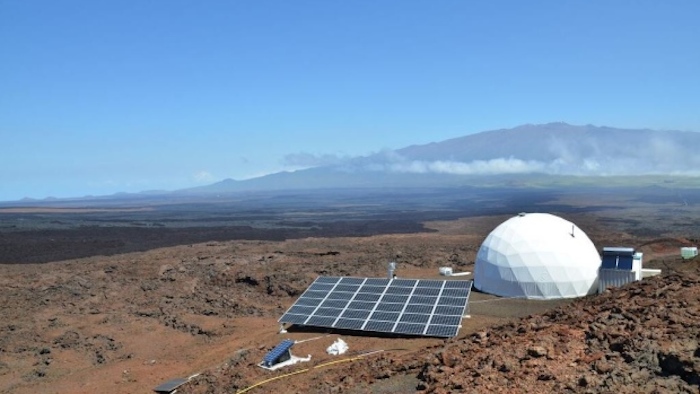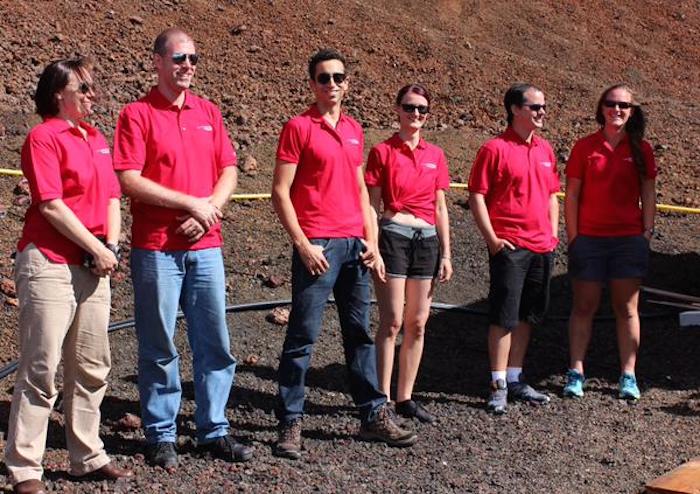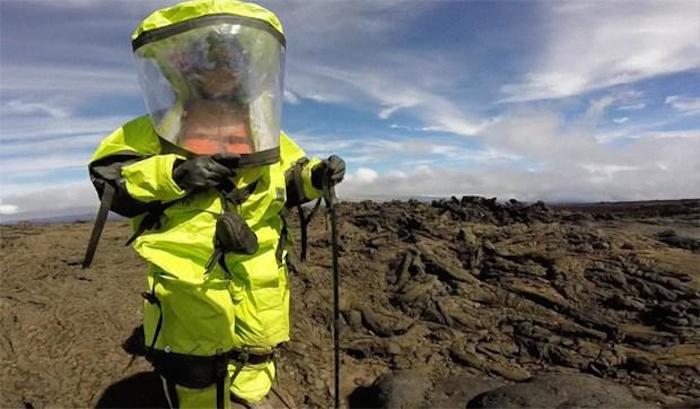Six scientists have completed a year-long simulation of a Mars mission, during which they lived in a dome in near-isolation.
The group lived in the dome on a Mauna Loa mountain in Hawaii and were only allowed to go outside if wearing spacesuits. On Sunday the simulation ended and the scientists emerged.
Previous simulations in the Mauna Loa dome, which is almost 11 metres (36 feet) in diameter and 6 metres (20 feet) tall, have lasted four to eight months. Mauna Loa soil is similar to what would be found on Mars. The area’s high elevation means there is almost no plant growth.
The group included a French astrobiologist, a German physicist and four Americans – a pilot, an architect, a doctor/journalist and a soil scientist.
They managed limited resources while conducting research and working to avoid personal conflicts.
After walking out of the dome crew members reflected on the experience and what it meant for the future of space travel.
Cyprien Verseux, a crew member from France, said the simulation showed a mission to Mars could succeed.
“I can give you my personal impression which is that a mission to Mars in the close future is realistic. I think the technological and psychological obstacles can be overcome,” Verseux said.
Christiane Heinicke, a crew member from Germany, said the scientists were able to find their own water in a dry climate.
“Showing that it works, you can actually get water from the ground that is seemingly dry. It would work on Mars and the implication is that you would be able to get water on Mars from this little greenhouse construct,” she said.
Crew member Sheyna Gifford wrote a blog post just before leaving about the future of space travel alluding to Nasa’s plans to send humans to Mars by 2030.
She said: “Given what it takes to keep people alive in the void – to keep them healthy on Mars for just a year – I can basically promise that by going to space we’ll learn what it takes to keep people healthy in places with heat, light, and gravity. We’ve already started. We’ve been at it for decades. I’ve been at it for 12 months straight, been on call for almost 365.25 days.”She also talked about her immediate plans upon leaving the dome. “I know what lies ahead for me, to some extent. My husband Ben is just outside the door, along with my mother, brother (also, Ben), and all of you.”
“What now? ... For me, for now – I’m going on vacation.”
An earlier blog alluded to the limited contact the team have had with the outside world. She joked: “In the last 24 hours, I’ve even contemplated having a business card made up that reads: ‘Recently returned from Mars. Please speak slowly. My sincerest apologies for knowing nothing about that song/movie/candidate for high political office/celebrity’s latest spouse/kid/dog/tattoo/“wardrobe malfunction”. For best results, avoid cultural references and make no sudden moves.’”
Kim Binsted, principal investigator for the Hawaii Space Exploration Analog and Simulation, said the researchers were looking forward to jumping into the ocean and eating fresh produce and other foods that were not available in the dome.
Nasa funded the study, which was run through the University of Hawaii. Binsted said the simulation was the second-longest of its kind, after a Russian mission that lasted 520 days.
Quelle: the guardian
.
Six People Isolated In A Dome Complete Yearlong NASA Experiment
The scientists, pretending to be astronauts, lived in a dome on a remote part of Hawaii for 365 days to simulate what a space mission to Mars might be like.
Six scientists on Sunday completed a yearlong isolation mission in a geodesic dome that they could only leave while wearing spacesuits.
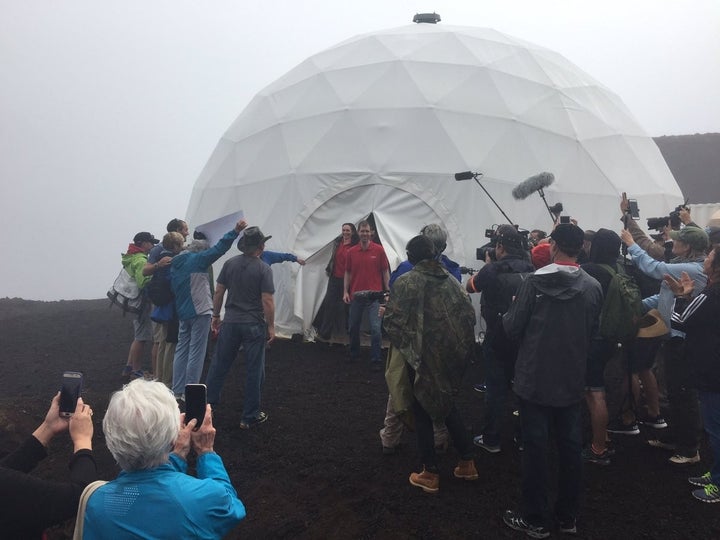
HI-SEAS / Via Twitter: @HI_SEAS
Scientists emerged on Sunday from the 1,000-square-foot dome on Hawaii’s Mauna Loa to a throng of reporters.
The six scientists — Carmel Johnston, Christiane Heinicke, Sheyna E. Gifford, Andrzej Steward, Cyprien Verseux and Tristan Bassingthwaighte — have been in the dome for 12 months to learn about challenges that might face future manned missions to Mars, like managing resources, growing food, and working out conflicts.
Just like in deep space, the crew members could only communicate with family and friends via a 20-minute delay and could only leave the dome in an elaborate mock spacesuit.
Christiane Heinicke, who is a German physicist and engineer, said that she was most excited to leave behind the spacesuits.
“The suits do prevent you from hearing and feeling your surroundings,” Heinicke said to BuzzFeed News. “No sound of your own steps makes it past the fan noise and every rock feels like the inside of your suit gloves.”
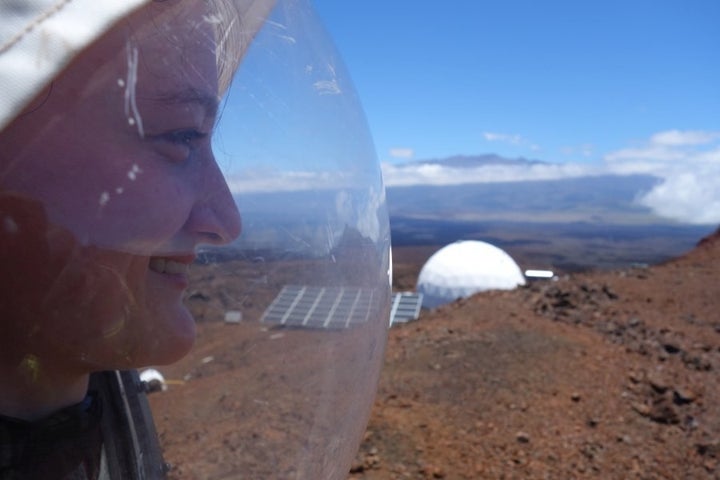
Christiane Heinicke / Via Twitter: @mars_christiane
Mauna Loa is considered an ideal location for the mission because of its relative remoteness and the terrain, which appears Mars-like with its red, rocky slopes.
The study is funded by NASA and run through the University of Hawaii. It’s Hawaii Space Exploration Analog and Simulation’s fourth mission of its kind, and the longest to date.
When asked what they would do first upon leaving the dome, Heinicke said, “Finally, swimming in the Pacific!”
The program is currently seeking applications for the next two isolation missions, which will send teams back to mock Mars in 2017 and 2018 for eight months each.
Quelle: BuzzFeed
-
Scientists exit Mauna Loa dome after yearlong Mars simulation
IVY ASHE/Tribune-Herald Andrzej Stewart, greeted by throngs of national and international media, prepares to exit the HI-SEAS habitat on Sunday after nearly one year living beneath the dome as part of a Mars simulation. The mission was the longest American simulation ever.

A physician, a physicist and an architect walk into a dome, along with an aerospace engineer, an astrobiologist and a soil scientist.
It’s not the start of a terrible joke but instead the premise of the fourth Hawaii Space Exploration Analog and Simulation mission, which came to a close Sunday.
A NASA-funded study, HI-SEAS aims to mimic living conditions on Mars, from location (8,200 feet up the slopes of Mauna Loa, on a reddish volcanic surface that looks and feels extraterrestrial) to protocol (crew members cannot leave the habitat dome without a spacesuit).
The fourth mission lasted 365 days and is the longest American Mars simulation to date. HI-SEAS is run by the University of Hawaii.
“I’m excited,” UH principal investigator Kim Binsted said Sunday morning before the front door of the dome was unzipped and the crew was welcomed by family, fellow researchers, and media outlets from as far away as Taiwan and France (two crew members are from Europe). “I’m excited to welcome them back.”
Trays of fresh fruit (pineapple, cantaloupe, watermelon, bananas, to name a few) were laid out as the crew’s first real breakfast. Only shelf-stable foods or freeze-dried items are allowed in the habitat, which consists of 1,200 square feet of floor space, a second-floor loft that has six small bedrooms, and an attached workshop.
The dome runs on solar power with hydrogen cells as backup fuel.
“Little by little, we’re trying to make it more real,” said Henk Rogers, chairman of Pacific International Space Center for Exploration Systems, which owns the dome and leases it to NASA and the universities. “In the future, we plan for them to make their own hydrogen.”
A year is a long time to spend in the same 1,200-foot space with the same group of people, and that’s exactly the point. Before sending any astronauts on missions to Mars, where resources are virtually nonexistent, NASA researchers need to know how to build the right team. They need to know how that team handles itself in the stress of isolation.
“It’s important that we protect the astronauts’ health, the astronauts’ safety, but we also need to protect their mental health,” said chief engineering officer Andrzej Stewart. “If you’ve got a crew that’s happy, that’s healthy, you’ve got a crew that can operate.”
Researchers from universities around the country conducted studies on team cohesion even as the crew itself was working on individual projects.
Crew commander Carmel Johnston worked on plant cultivation.
“I want to find a sustainable way for people to grow in space,” she said. “I think the things we were able to figure out here will help us get into that mindset.” Kale, chard, radishes and tomatoes thrived in the habitat. Red peppers did not.
For the crew, maintaining a work-life balance was difficult, considering they lived at their own job site.
“The biggest thing is finding enough time for yourself, and not thinking ‘I need to do this, that, or the other thing,” Johnston said. “There’s always something to do. It’s hard for six overachievers to do that (step away).”
Though crew members like Johnston and Stewart had long wanted to participate in a space simulation misson, others, like crew architect Tristan Bassingthwaighte, applied on a whim. Bassingthwaighte was studying in Shanghai, in the middle of graduate research on space architecture. He sent off the application after corresponding with HI-SEAS III crew member Jocelyn Dunn.
“I’m not a scientist at all,” he said. “I thought maybe I’d get some information (for my research) during the interview process….I went from not knowing about HI-SEAS to being in the dome in about three and a half months.”
Bassingthwaighte’s research involves designing for people are going to be in “far rougher” places than Mauna Loa, and having firsthand experience with what works and what doesn’t work was enlightening.
“A big one would just be privacy in general,” he said. There is no soundproofing in the dome, for example, he said, “Andrzej will play his Green Day music when he’s cooking on Sundays, and you hear it no matter where you are.”
During down time, crew members read, knitted, watched movies, played Minecraft, and salsa danced. They explored nearby lava tubes from the safety of their space suits, and exchanged presents on holidays and birthdays.
At Thanksgiving, virtual reality — a first for HI-SEAS, and an initiative of NASA research partner Smart Information Flow Technologies — allowed them to “sit” at a table with their families and listen to what everyone was thankful for.
“It’s certainly very rewarding,” said SIFT senior researcher Peggy Wu.
Chief medical officer and crew journalist Sheyna Gifford said she had been impressed by the group’s overall dynamic when it came to solving problems.
“As individuals, we’d get stuck,” she said. “As a group, we could work through it. I don’t think there’s a problem we weren’t able to work through (together).” That was particularly true two weeks ago, when the plumbing system failed and the crew had to figure out how to repair it.
And the crew went in knowing they could expect some conflicts.
“One of the challenges was to talk among the group, and meet the conflicts head on, and make sure they don’t escalate,” said chief scientific officer and crew physicist Christiane Heinecke, who is also a cello-playing engineer.
Isolation presented other challenges, particularly regarding separation from family and friends. Although the crew could correspond with people in the outside world, they did so on a 20-minute delay to better mimic Martian conditions. Gifford’s grandmother passed away. Crew biologist Cyprien Verseux, a native of France, had to learn about last November’s terrorist attack in Paris from inside the bubble.
Still, during a morning press conference all members said they’d do the simulation again.
“There’s just the focus of the mission, wanting to achieve something greater than yourself,” Stewart said.
The crew was able to pass that sentiment on throughout the year, though a HI-SEAS blog that let the world know about their work.
“I did not anticipate that people would be so supportive,” Gifford said. “I did not see that coming…all people, everywhere, people just come together.”
“When it comes to space, I think we’re at our best,” she said. “We drop our pettiness, we assume a global outlook, we are bold, we are brilliant, we are unstoppable.”
There are two more HI-SEAS missions planned, both set to last eight months. An application form is available at http://hi-seas.org/?p=5695 and must be received by September 5.
Quelle: West Hawaii Today

